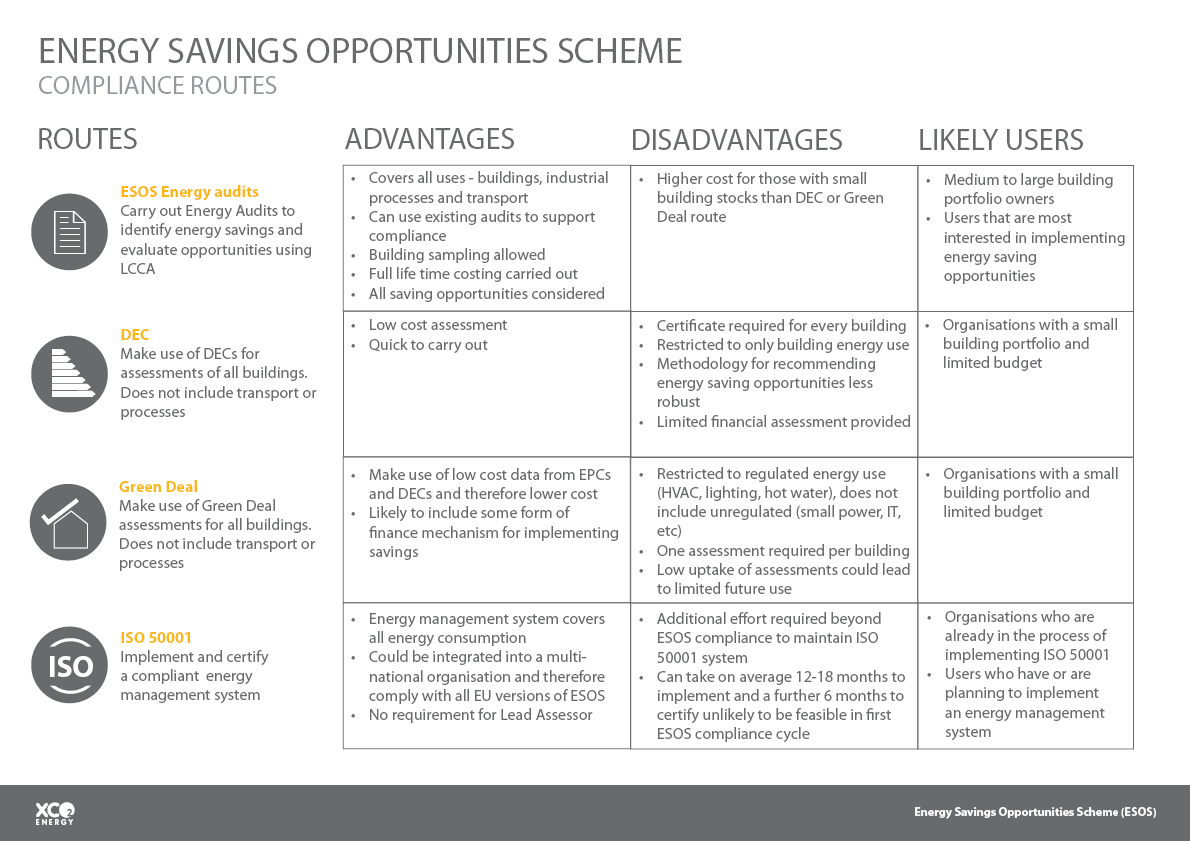First steps for clients prior to engaging an assessor. What is the role of the Lead Assessor? How does the chosen route influence cost and outcomes of the process? Do the skills of the auditor align with the specific energy uses?
The 5th January marked the 11-month countdown before ESOS must be complied with. For those organisations that are not quite up to speed, now is the time to begin to determine a compliance strategy and, where necessary, engage any expertise that may be required. The intention of the next few paragraphs is to demonstrate the process that clients should go through in order to get the most out of the scheme as well as pointing out some of the shortcuts and pitfalls.
As briefly discussed in our last post the scheme effectively requires participating companies to go through a 5 step process:
- Measure energy use – all energy across buildings, transport and industry
- Identify energy efficiency and management opportunities – 90% of total energy must be subject to an ES0S compliance route (energy audit,DEC, Green Deal or ISO50001)
- Evaluate opportunities via life cycle costing
- Store data and notify scheme administrator – In the case of England this is the Environment Agency
- Implement energy saving measures. Whilst this is not a mandatory part of ESOS, this is where companies can leverage the greatest value from the scheme
DIY As with many things (learning to walk, skydiving, building a staircase) the first step is crucial in setting out a path for how you mean to go on. This step should also be within the capabilities of most organisations without external assistance. Utility bills, half-hourly metered energy data, fuel receipts, tachograph readouts can all be used to quantify total energy use across a 12-month period. Any larger firms that are covered by CRC will already have gone through much of this process. One potential pitfall to look out for is the need to convert data collected into a consistent unit, preferably kWh using suitableconversion factors. Once the total energy use is determined ESOS participants move onto step 2 for all areas of significant energy consumption (e.g. buildings, transport etc.) that cumulatively are greater than 90% of the total energy. This de minimis rule provides some leniency in the scope of identifying efficiency opportunities. For example, an organisation with a large building stock and a company car scheme would be able to ignore the fuel used in their vehicles if the building stock energy exceeded 90% of the total.
Routes to Compliance Step 2 is where the real work begins and in most circumstances will be where a Lead Assessor is appointed. With the exception of ISO 50001 certified Energy Management Systems, a qualified Lead Assessor must oversee or conduct the ESOS assessment. A summary of the advantages and disadvantages of each route are provided below.
Advantages and disadvantages of ESOS compliance routes
Sampling A significant area for reducing the reach of ESOS within a firm is the use of energy audit sampling. This practice allows organisations to energy audit a representative selection of their buildings, with any energy saving opportunities identified, attributable to the whole building portfolio. It is down to individual Lead Assessor to determine what level of building sampling is reasonable for an organisation and therefore this represents a considerable area for shortcuts. Some level of sampling is sensible for those with large building portfolios but DECC should consider providing guidance on the level of sampling expected in order to avoid possible malpractice.
Lead Assessor Tips To get the most of out of your Lead Assessor, organisations may want to consider the following in order to ensure that a clear scope is defined for the Assessor to quote against:
- What is your total energy use and what data do you have available? See step 1 above
- Have any energy audits been done previously (no earlier than 6th December 2010 for the first compliance cycle) that could be used for ESOS compliance?
- Can you use the 90% rule to exclude areas of relatively insignificant energy consumption (e.g. vehicle fuel)?
- Which ESOS compliance route (energy audit, DEC, Green Deal or ISO50001) is most appropriate for your organisation’s needs (see table above)?
- What level of sampling could be used to streamline the energy audit scope?
- What previous experience does the Lead Assessor have and does it align to your organisations areas of energy use? For, example a haulage logistics firm should look for a Lead Assessor with a background in transport energy analysis. Those with a significant building portfolio should look for a building energy specialist
- Is a robust energy audit methodology (e.g. ISO 50002 or BS EN 16247) proposed?
- What type of energy saving opportunities (building fabric, HVAC, lighting, energy management etc) will the Lead Assessor consider?
- What financial analysis (simple payback, discounted payback, ROI, NPV etc) will the Lead Assessor provide on any measures that are uncovered?
Beyond Compliance A suitable Lead Assessor via the energy audit route must carry out life time costing based on a combination of metered energy consumption and reasonable estimates of expected savings. A similar robust process is not currently a part of the Green Deal or DEC methodologies. It would seem therefore that audits represent the best opportunity for identifying energy efficiency measures in a manner that provides sufficiently robust information to allow organisation to go beyond compliance.
Whichever compliance route organisations take, the hope is they embrace the main objective of ESOS (promoting energy efficiency) and make full use of the skills of Lead Assessors. It would be a great shame if ESOS became yet another bureaucratic compliance report that sits on a shelf and is never acted upon.
Next Blog Our next blog of the series will discuss the ESOS performance gap. Will the scheme lead to actual energy savings? How will energy saving measures be financed?


